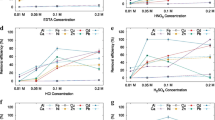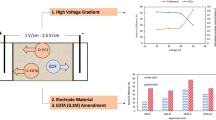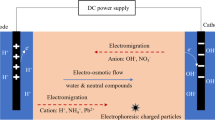Abstract
Given copper and lead mine enrichment and the high yield of North-Western China, the metallurgical industry attains prosperity. Metallurgical industrial waste which contains heavy metals can cause contamination and threaten the fragile loess environment. The disposal of hazardous waste is becoming a challenging and unavoidable task when land contamination consistently raises environmental concerns. Electrokinetic (EK) technology is an increasingly popular alternative to traditional approaches for contaminated soil remediation because of its high time effectiveness and low risk of secondary pollution. This study investigates the effect of degree of compaction, initial water content, and electric field intensity on the percentage removal of heavy metals in the loess. An EK reactor applied to the EK experiments is set up to measure pH, electric conductivity (EC), and electromigration of cation and heavy metal ions. The experimental results indicate that the lower degree of compaction promoted the formation of the agglomerate structure, and therefore, caused the electromigration path wider and straighter towards elevating the percentage removal of heavy metals. Furthermore, the slippage of the Gouy layer aggravated the electromigration of the cations and heavy metal ions when subjected to the higher initial water content, thereby enhancing the percentage removal of heavy metals. Moreover, the electromigration of the cations and heavy metal ions was notably accelerated by the higher electric current resulting from the higher electric field intensity. The removal of heavy metals was improved accordingly. These results, however, also highlighted the deteriorated percentage removal by the precipitation of heavy metal compounds at the cathode, induced by the alkaline front. A dynamic pH regulation during the EK remediation and a permeable reactive barrier to separate the heavy metal ions from the hydroxide ions are deemed as of great necessity for optimising the removal of heavy metals in the loess.


















Similar content being viewed by others
Data availability statement
All data generated or analyzed during this study are included in this published article.
References
Acar YB, Alshawabkeh AN (1993) Principles of electrokinetic remediation. Environ Sci Technol 27(13):2638–2647
Alshawabkeh AN, Yeung AT, Bricka MR (1999) Practical aspects of in-situ Electrokinetic extraction. J Environ Eng 125(1):27–35
Al-Shahrani SS, Roberts EPL (2005) Electrokinetic removal of caesium from kaolin. J Hazard Mater 122:91–101
Bai XD, Cheng WC, Li G (2021) A comparative study of different machine learning algorithms in predicting EPB shield behaviour: a case study at the Xi’an metro China. Acta Geotech 16(12): 4061–4080
Bai B, Nie QK, Zhang YK, Wang XL, Hu W (2021) Cotransport of heavy metals and SiO2 particles at different temperatures by seepage. J Hydrol 597:125771
Brunauer S, Emmett PH, Teller E (1938) Adsorption of gases in multimolecular layers. J Am Chem Soc 60(2):309–319
Beyrami H (2020) Effect of different treatments on electrokinetic remediation of Zn, Pb and Cd from a contaminated calcareous soil. Chinese J Chem Eng. https://doi.org/10.1016/j.cjche.2020.09.011.
Du YJ, Fan RD, Reddy KR, Liu SY, Yang YL (2015) Impacts of presence of lead contamination in clayey soil–calcium bentonite cutoff wall backfills. Appl Clay Sci 108:111–122
Duan Z, Yan XS, Sun Q, Tan X, Dong CX (2021) Effects of water content and salt content on electrical resistivity of loess. Environ Earth Sci 80:469
Fagnano M, Agrelli D, Pascale A, Adamo P, Fiorentino N, Rocco C, Pepe O, Ventorino V (2020) Copper accumulation in agricultural soils: risks for the food chain and soil microbial populations. Sci Total Environ 734:139434
Frick H, Tardif S, Kandeler E, Holm PE, Brandt KK (2019) Assessment of biochar and zero-valent iron for in-situ remediation of chromated copper arsenate contaminated soil. Sci Total Environ 655:414–422
Ghobadi R, Altaee A, Zhou JL, McLean P, Ganbat N, Li DH (2021) Enhanced copper removal from contaminated kaolinite soil by electrokinetic process using compost reactive filter media. J Hazard Mater 402:123891
Hu WL, Cheng W-C, Wen SJ, Rahman M (2021) Effects of chemical contamination on microscale structural characteristics of intact loess and resultant macroscale mechanical properties. CATENA 203:105361
Hu WL, Cheng WC, Wen SJ, Yuan K (2021) Revealing the Enhancement and Degradation Mechanisms Affecting the Performance of Carbonate Precipitation in EICP Process. Front Bioeng Biotechnol 9:750258
Hu WL, Cheng WC, Wang L, Xue ZF (2022) Micro-structural characteristics deterioration of intact loess under acid and saline solutions and resultant macro-mechanical properties. Soil Tillage Res 220:105382
Iannelli R, Masi M, Ceccarini A, Ostuni MB, Lageman R, Muntoni A, Spiga D, Polettini A, Marini A, Pomi R (2015) Electrokinetic remediation of metal-polluted marine sediments: experimental investigation for plant design. Electrochim Acta 181:146–159
Juan AO, Peng CS, Abou-Shady A (2012) Simultaneous removal of cadmium from kaolin and catholyte during soil electrokinetic remediation. Desalination 300:1–11
Lee HH, Yang JW (2000) A new method to control electrolytes pH by circulation system in electrokinetic soil remediation. J Hazard Mater 77:227–240
Liu Y, Chen J, Cai Z, Chen R, Sun Q, Sun M (2016) Removal of copper and nickel from municipal sludge using an improved electrokinetic process. Chem Eng J 307:1008–1016
Maria VG, Brahim A, Carlos VA, Cesar GL, Jose MRM, Juan MPG (2019) Electrodialytic processes in solid matrices. New insights into batteries recycling. A review. J Chem Technol Biotechnol 94(6):1727–1738.
Matteo M, Renato I, Gabriella L (2015) Ligand-enhanced electrokinetic remediation of metal-contaminated marine sediments with high acid buffering capacity. Environ Sci Pollut Res 23(11):10566–10576
National Bureau of Statistics (2001) China Statistical Yearbook. China National Publishing House, Beijing, China
National Bureau of Statistics (2018) China Statistical Yearbook. China National Publishing House, Beijing, China
Obiri-Nyarko F, Grajales-Mesa SJ, Malina G (2014) An overview of permeable reactive barriers for in situ sustainable groundwater remediation. Chemosphere 111:243–259
Pedersen KB, Jensen PE, Ottosen LM, Barlindhaug J (2018) Influence of electrode placement for mobilising and removing metals during electrodialytic remediation of metals from shooting range soil. Chemosphere 210:683–691
Qian P, Schoenau JJ (2002) Practical applications of ion exchange resins in agricultural and environmental soil research. Can J Soil Sci 82(1):9–21
Ramadan BS, Sari GL, Rosmalina RT, Effendi AJ, Hadrah (2018) An overview of electrokinetic soil flushing and its effect on bioremediation of hydrocarbon contaminated soil. J Environ Manage 218:309–321
Ryu BG, Park GY, Yang JW, Baek K (2011) Electrolyte conditioning for electrokinetic remediation of As, Cu, and Pb-contaminated soil. Sep Purif Technol 79(2):170–176
Sadiya A, Shafinaz S, Norahim I, Mohammed JN, Dai VNV, Fazilah AM (2021) Arsenic removal technologies and future trends: a mini review. J Clean Prod 278:123805
Souilah O, Akretche DE, Cameselle C (2012) Electroremediation of contaminated soil by heavy metals using ion exchange fibers. Electrochim Acta 86:138–141
Song Y, Cang L, Xu HT, Wu S, Zhou DM (2019) Migration and decomplexation of metal-chelate complexes causing metal accumulation phenomenon after chelate-enhanced electrokinetic remediation. J Hazard Mater 377:106–112
Suzuki T, Kawai K, Moribe M, Niinae M (2014) Recovery of Cr as Cr(III) from Cr(VI)-contaminated kaolinite clay by electrokinetics coupled with a permeable reactive barrier. J Hazard Mater 278:297–303
Suzuki T, Niinae M, Koga T, Akita T, Ohta M, Choso T (2014b) EDDS-enhanced electrokinetic remediation of heavy metal-contaminated clay soils under neutral pH conditions. Colloids Surf A Physicochem Eng Aspects 440:145–150.
Virkutyt J, Sillanpaa M, Latostenmaa P (2002) Electrokinetic soil remediation—critical overview. Sci Total Environ 289(1–3):97–121
Wang GY, Zhang SR, Zhong QM, Xu XX, Li T, Jia YX, Zhang YZ, Peijnenburg WJGM, Vijver MG (2018) Effect of soil washing with biodegradable chelators on the toxicity of residual metals and soil biological properties. Sci Total Environ 625:1021–1029
Wang L, Cheng WC, Xue ZF (2022) Investigating microscale structural characteristics and resultant macroscale mechanical properties of loess exposed to alkaline and saline environments. Bull Eng Geol Environ 81(4):146
Wang L, Cheng W-C, Xue Z-F (2022) The Effect of Calcium Source on Pb and Cu Remediation Using Enzyme-Induced Carbonate Precipitation. Front Bioeng Biotechnol 10:849631
Wang YC, Li A, Cui CW (2020) Remediation of heavy meatal-contaminated soils by electrokinetic technology: Mechanisms and applicability. Chemosphere 265:129071
Xu PP, Zhang QY, Qian H, Li MN, Yang FX (2021) An investigation into the relationship between saturated permeability and microstructure of remolded loess: a case study from Chinese Loess Plateau. Geoderma 382:114774
Xue ZF, Cheng WC, Wang L, Song GY (2021) Improvement of the shearing behaviour of loess using recycled straw fiber reinforcement. KSCE J Civ Eng 25(9):3319–3335
Xue ZF, Cheng WC, Wang L, Hu WL (2022) Effects of bacterial inoculation and calcium source on microbial-induced carbonate precipitation for lead remediation. J Hazard Mater 426:128090
Yan XS, Duan Z, Sun Q (2021) Influences of water and salt contents on the thermal conductivity of loess. Environ Earth Sci 80:52
Yeung AT, Gu YY (2011) A review on techniques to enhance electrochemical remediation of contaminated soils. J Hazard Mater 195:11–29
Yuan LZ, Li HY, Xu XJ, Zhang J, Wang NN, Yu HW (2016) Electrokinetic remediation of heavy metals contaminated kaolin by a CNT-covered polyethylene terephthalate yarn cathode. Electrochim Acta 213:140–147
Yuan LZ, Xu XJ, Li HY, Wang NN, Guo N, Yu HW (2016) Development of novel assisting agents for the electrokinetic remediation of heavy metal-contaminated kaolin. Electrochimca Acta 218:140–148
Yuan LZ, Xu XJ, Li HY, Wang QY, Wang NN, Yu HW (2017) The influence of macroelements on energy consumption during periodic power electrokinetic remediation of heavy metals contaminated black soil. Electrochimca Acta 235:604–612
Zhou D, Deng C, Cang L, Alshawabkeh AN (2005) Electrokinetic remediation of a Cu-Zn contaminated red soil by controlling the voltage and conditioning catholyte pH. Chemosphere 61(4):519–527
Zhang DF, Wang JD, Chen CL (2020) Gas and liquid permeability in the variably saturated compacted loess used as an earthen final cover material in landfill. Waste Manage 105:49–60
Acknowledgments
This paper is based upon work supported by the Shaanxi Educational Department under Grant No. 2020TD-005 through the innovative ability support scheme.
Author information
Authors and Affiliations
Contributions
WLH: Data curation, Formal analysis, Validation, Software, Writing—original draft. W-CC: Conceptualisation, Methodology, Writing—review & editing, Supervision, Funding acquisition. SJW: Data curation, Formal analysis, Validation, Software, Writing—original draft.
Corresponding author
Ethics declarations
Conflict of interest
The authors declare that they have no known competing financial interests or personal relationships that could have appeared to influence the work reported in this paper.
Additional information
Publisher's Note
Springer Nature remains neutral with regard to jurisdictional claims in published maps and institutional affiliations.
Rights and permissions
About this article
Cite this article
Hu, W., Cheng, WC. & Wen, S. Investigating the effect of degree of compaction, initial water content, and electric field intensity on electrokinetic remediation of an artificially Cu- and Pb-contaminated loess. Acta Geotech. 18, 937–949 (2023). https://doi.org/10.1007/s11440-022-01602-9
Received:
Accepted:
Published:
Issue Date:
DOI: https://doi.org/10.1007/s11440-022-01602-9




